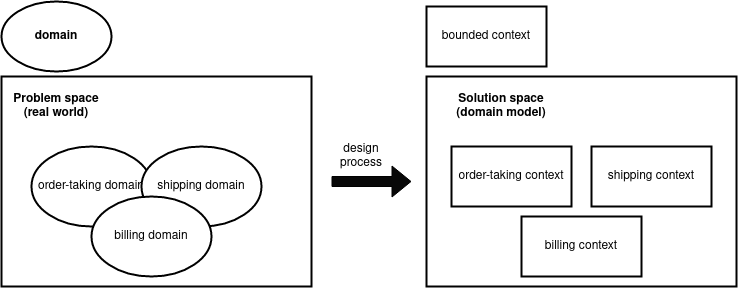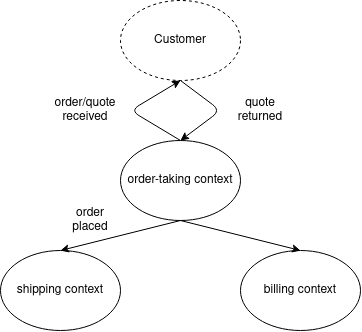Domain Modeling Made Function #1: Introducing Domain-Driven Design
Posted on September 04, 2022
Introduction
I want to understand DDD better because from what I have seen so far it is very well suited approach for business focused developments. I already read once the book that I will follow in this series of posts which is called "Domain Modeling Made Functional" by Scott Wlaschin. But reading is not the same as deliberate practice. Also the subject is complex enough that it warrants re-reading on its own. This time I will be more insistent on formulating my knowledge into words and even more importantly I will use that knowledge to implement an actual application.
This application will be a simple one. It will be a digital daily notebook. Nothing more, nothing less. A user can write a note for each day in the calendar. A user can login, write a note for that day, a day in the future, a day in a past, read a note from any day, edit a note from any day. Why I would like something like this? Personally when I work I always note what I did on the day and I write on what I want to do the next day. It is like a little history for me I can go back to as well. I guess this is the MVP.
Introducing Domain-Drive Design
In the introduction to the chapter, I like how the author compares software development to a pipeline with an input which is requirements and an output which is the final delivered product. When we think of software development in that way the rule garbage in, garbage out applies. If the requirements (input) are unclear then how can we expect the output to be correct?
DDD is supposed to minimize the garbage in part by emphasizing on clear communication and shared domain knowledge.
All that said DDD is not a tool that can be applied to every problem. Different types of software (games, systems software, etc.) might be better suited for other approaches. However, the business and enterprise software where non-technical teams must be included in the collaboration usually works incredibly well with DDD.
The importance of shared model
It is of utmost importanec for developers to understand the problem at hand. Without that understanding, they won't be able to produce a suting solution.
Many existing software development processes try to bridge the gap of understanding by writing formal specifications that capture all the details. Unfortunately, this creates a distance between the people who understand the problem (domain experts) and people who implement the solution (developers, ui/ux experts, testers, etc.).
That lacking process could look like this. Domain experts communicate with business analysts to create requirements document. That document is forwarded to an architect who then creates a design document. This is then forwarded to the development team who does the actual implementation.
We can see that in this approach the distance between the domain experts and the development team is maximized. Because of this a lot of domain knowledge is lost in translation. The author says that the initial message is distorted. A mismatch between the requirements and the solution becomes real.
A much better one is to put developers and domain experts next to each other. This is more aligned with todays agile development. But this still entails that the developers perform a translation of the domain experts' model into code. The code loses the subtleties of the domain model and with each passing day, diverges from that model. Code starts to less resemble the concepts of the domain and misunderstanding will pop up.
Finally, what is recommended is to put domain experts, development team, stakeholders and most importantly the code together. The code shall represent a shared mental model. No translation, the code itself ought to represent the domain exactly as it is put out.
What are the benfits of aligning the software model with the business domain?
- Faster time to market. Shared model makes it easier to develop correct solution quicker.
- More business value. A solution that is aligned with the problem means
happier customers.
Krzysztof: This is rather vague?
- Less wate. Clear requirements mean less time wasted in misunderstandings and reworks.
- Easier to maintance and evolution. Making changes to the code is easier and less error-prone. New team members are abler to come up to speed faster.
So how do we create a shared model? Here are the guidelines.
- Focus on business events and workflows rather than data structures.
- Partition the problem into smaller subdomains.
- Create a model of each subdomain in the solution.
- Develop a common language (Ubiquitous Language) that is shared between everyone involved in the project and is usedf everywhere in the code..
Understanding the Domain Thtough Business Events
We should focus not on the data we operate on but on the transformations
that occur inside the domain. The values of the business is hidden inside
those transformations. What triggers those transformations are Domain
Events. This is an important part that we need to capture in our design.
Those events are most often starting points for all business processes.
For example, an OrderFormReceived event might kick off an order-taking
process that processes the form.
Using Event Storming to Disover the Domain
To discover the events inside our domain we do the Event Storming. We gather all the domain experts, developers, stakeholders, and pretty much all the people involved. Then people write out their event and what workflows they trigger.
This approach allows us to:
- build a shared model of the business,
- build awarness of all the teams that exist,
- finding the gaps in the requirements,
- make connections that exist between teams,
- awarness of reporting requirements (kind of ui requirements).
There are many different terms to desribe business activites, i.e., workflows, scenarios, use cases, processes. They are often used interchangibly but the devil is in the details.
- A scenario describes a goal that a customer/user wants to achieve, such as placing an order. It corresponds to a story in agile development. What is important is that they are user centric.
- A business process describes the goal of the business instead of focusing on the user. It has a business centric focus.
- A workflow is a detailed descriptions of part of a business. It is a list of exact steps that an employee (or software component) needs to perform to acomplish a business goal.
Documenting commands
Once we have defined the events, the next step is to ask what caused them. Those we call commands. Command initiates a workflow. If that workflow succeeds it emits and event.
Command: Make X happen, Workflow: Make X happend, Event: X happened.

Krzysztof: It is a little bit weir that commands and workflows usually have the same name and can be confusing, but they are not exactly the same. More on that later.
Not all events must be associated with a command. Some events might be triggered by some external system like a scheduler or a monitoring system.
Partitioning Domain into Subdomains
A domain can usually be separated into several subdomains. But what is a domain anyway. The author defines it as:
A domain is an area in which a domain expert is an expert.
Whatever it means. I like to think that a domain is an area in which an internal shared model exists that does not crossover to other domains (even if the language is similar or even the same for some concepts).
Creating a Solution Using Bounded Contexts
Our solution should only capture the information necessary to solving a particular problem, not the whole domain. Thus we have to create a distinction between problem space and solution space. Solution space extracts only relevant information from the problem space that are necessary for the implementation.
These solution spaces we call bounded contexts.

Bounded context
A bounded context is a subsystem in the solution space with clear boundaries that distinguish it from other subsystems. In other words, it is also an implementation of a domain.
Bounded contexts usually have a one-to-one correspondence with domains in the problem space, but it is not a rule. Multiple domains may be represented by a one boundary context. For example when you use a prebuilt component that solves problems related to a couple of domains.
It is important that each bounded context has a clear responsibility, because it usually corresponds to some software component, whether it is a service, DLL, or something else.
When defining bounded contexts listed by the domain experts, pay attention to existing team and department boundaries, and don't forget that it is bounded.
Getting the contexts right
Advices for formulating bounded contexts are:
- listen to domain experts,
- pay attention to existing team and department boundaries,
- don't forget the "bounded" part,
- design for autonomy,
- design for friction-free business workflows.
Creating context maps
Context maps define what are the relationships between our bounded contexts.

They can be more detailed with well defined contracts between the contexts. More on that in later chapter.
Creating Ubiquitous Language
Inside the domain we should not have terms that are not domain specific. Things
like OrderManager shall not exist. If there is a term that a domain expert
would not understand it should not be there, or at least they should not
be exposed.
It is also important to understand that different bounded contexts might have their own dialects of the Ubiquotious Lanaguage or the same word can have two different meanings inside them.
It is important to note these differences.
Summary
- A domain is an area of knowledge that which a "domain expert" is expert in.
- A Domain Model is a set of simplifications that represent those aspects of a domain that are relevent to a particular problem. The domain model is part of the solution space, while the domain it represents is a part of problem space.
- The Ubiquotious Language is a set of concepts and vocabulary that is associated with the domain and shared between everyone involved and the code.
- A Bounded Cotext is a subsystem in a solution space with clear boundaries that distinguish it from other subsystems. It corresponds to a subdomain in a problem space. A bounded cotext has its own set of concepts and vocabulary that might be a dialect of Ubiquotious.
- A Cotext Map is a diagram that defines relationships between bounded contexts.
- A Domain Event is a record of something that happened in a system. It often acts as a trigger to a command.
- A Command is a request for some process to happen and is triggered by an event. If the command succeeds the state of the system changes and a new event is emited.